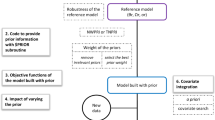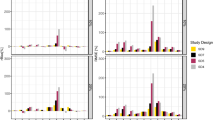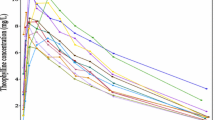Abstract
The utilisation of physiologically-based pharmacokinetic models for the analysis of population data is an approach with progressively increasing impact. However, as we move from empirical to complex mechanistic model structures, incorporation of stochastic variability in model parameters can be challenging due to the physiological constraints that may arise. Here, we investigated the most common types of constraints faced in mechanistic pharmacokinetic modelling and explored techniques for handling them during a population data analysis. An efficient way to impose stochastic variability on the parameters of interest without neglecting the underlying physiological constraints is through the assumption that they follow a distribution with support and properties matching the underlying physiology. It was found that two distributions that arise through transformations of the normal, the logit-normal generalisation and the logistic-normal, are excellent for such an application as not only they can satisfy the physiological constraints but also offer high flexibility during characterisation of the parameters’ distribution. The statistical properties and practical advantages/disadvantages of these distributions for such an application were clearly displayed in the context of different modelling examples. Finally, a simulation study clearly illustrated the practical gains of the utilisation of the described techniques, as omission of population variability in physiological systems parameters leads to a biased/misplaced stochastic model with mechanistically incorrect variance structure. The current methodological work aims to facilitate the use of mechanistic/physiologically-based models for the analysis of population pharmacokinetic clinical data.













Similar content being viewed by others
References
Tsamandouras N, Rostami-Hodjegan A, Aarons L (2015) Combining the “bottom-up” and “top-down” approaches in pharmacokinetic modelling: fitting PBPK models to observed clinical data. Br J Clin Pharmacol 79(1):48–55
Tsamandouras N, Dickinson G, Guo Y, Hall S, Rostami-Hodjegan A, Galetin A, Aarons L (2015) Development and application of a mechanistic pharmacokinetic model for simvastatin and its active metabolite simvastatin acid using an integrated population PBPK approach. Pharm Res 32(6):1864–1883. doi:10.1007/s11095-014-1581-2
Aitchison J, Shen SM (1980) Logistic-normal distributions: some properties and uses. Biometrika 67(2):261–272
Lavielle M (2014) Mixed effects models for the population approach. Models, tasks, methods & tools. Chapman & Hall/CRC Biostatistics Series, Boca Raton
van der Walt JS, Hong Y, Zhang L, Pfister M, Boulton DW, Karlsson MO (2013) A nonlinear mixed effects pharmacokinetic model for dapagliflozin and dapagliflozin 3-o-glucuronide in renal or hepatic impairment. CPT: Pharmacomet Syst Pharmacol 2:e42
Gueorguieva I, Aarons L, Rowland M (2006) Diazepam pharamacokinetics from preclinical to Phase I using a Bayesian population physiologically based pharmacokinetic model with informative prior distributions in Winbugs. J Pharmacokinet Pharmacodyn 33(5):571–594
Langdon G, Gueorguieva I, Aarons L, Karlsson M (2007) Linking preclinical and clinical whole-body physiologically based pharmacokinetic models with prior distributions in NONMEM. Eur J Clin Pharmacol 63(5):485–498
Gelman A, Carlin JB, Stern HS, Rubin DB (1995) Bayesian data analysis, 1st edn. Chapman & Hall, London
Coleman T, Li Y (1996) An interior trust region approach for nonlinear minimization subject to bounds. SIAM J Optimiz 6(2):418–445
Aitchison J (1982) The statistical analysis of compositional data. J Roy Stat Soc B Met 44(2):139–177
Blei DM, Lafferty JD (2007) A correlated topic model of science. Ann Appl Stat 1(1):17–35
Minka T (2000) Estimating a Dirichlet distribution. Technical report. http://researchmicrosoftcom/en-us/um/people/minka/papers/dirichlet/minka-dirichletpdf
Read NW, Al-Janabi MN, Holgate AM, Barber DC, Edwards CA (1986) Simultaneous measurement of gastric emptying, small bowel residence and colonic filling of a solid meal by the use of the gamma camera. Gut 27(3):300–308
Read NW, Cammack J, Edwards C, Holgate AM, Cann PA, Brown C (1982) Is the transit time of a meal through the small intestine related to the rate at which it leaves the stomach? Gut 23(10):824–828
Zhang X, Lionberger RA, Davit BM, Yu LX (2011) Utility of physiologically based absorption modeling in implementing quality by design in drug development. AAPS J 13(1):59–71
Peters SA (2008) Evaluation of a generic physiologically based pharmacokinetic model for lineshape analysis. Clin Pharmacokinet 47(4):261–275
Lartigue S, Bizais Y, Bruley des Varannes S, Murat A, Pouliquen B, Galmiche JP (1994) Inter- and intrasubject variability of solid and liquid gastric emptying parameters. Dig Dis Sci 39(1):109–115
Jamei M, Turner D, Yang J, Neuhoff S, Polak S, Rostami-Hodjegan A, Tucker G (2009) Population-based mechanistic prediction of oral drug absorption. AAPS J 11(2):225–237
Yu LX, Crison JR, Amidon GL (1996) Compartmental transit and dispersion model analysis of small intestinal transit flow in humans. Int J Pharm 140(1):111–118
Gertz M, Tsamandouras N, Säll C, Houston JB, Galetin A (2014) Reduced physiologically-based pharmacokinetic model of repaglinide: impact of OATP1B1 and CYP2C8 genotype and source of in vitro data on the prediction of drug-drug interaction risk. Pharm Res 31(9):2367–2382
Kawai R, Mathew D, Tanaka C, Rowland M (1998) Physiologically based pharmacokinetics of Cyclosporine A: extension to tissue distribution kinetics in rats and scale-up to human. J Pharmacol Exp Ther 287(2):457–468
Price PS, Conolly RB, Chaisson CF, Gross EA, Young JS, Mathis ET, Tedder DR (2003) Modeling interindividual variation in physiological factors used in PBPK models of humans. Crit Rev Toxicol 33(5):469–503
Jamei M, Marciniak S, Feng K, Barnett A, Tucker G, Rostami-Hodjegan A (2009) The Simcyp® population-based ADME simulator. Expert Opin Drug Metab Toxicol 5(2):211–223
Wendling T, Ogungbenro K, Pigeolet E, Dumitras S, Woessner R, Aarons L (2014) Model-based evaluation of the impact of furmulation and food intake on the complex oral absorption of mavoglurant in healthy subjects. Pharm Res 32(5):1764–1778. doi:10.1007/s11095-014-1574-1
Zhou H (2003) Pharmacokinetic strategies in deciphering atypical drug absorption profiles. J Clin Pharmacol 43(3):211–227
Csajka C, Drover D, Verotta D (2005) The use of a sum of inverse Gaussian functions to describe the absorption profile of drugs exhibiting complex absorption. Pharm Res 22(8):1227–1235
Rowland M, Peck C, Tucker G (2011) Physiologically-based pharmacokinetics in drug development and regulatory science. Annu Rev Pharmacol Toxicol 51(1):45–73
Nestorov I (2003) Whole body pharmacokinetic models. Clin Pharmacokinet 42(10):883–908
Brown RP, Delp MD, Lindstedt SL, Rhomberg LR, Beliles RP (1997) Physiological parameter values for physiologically based pharmacokinetic models. Toxicol Ind Health 13(4):407–484
Hoff PD (2003) Nonparametric modeling of hierarchically exchangeable data. University of Washington Statistics Department, Technical Report 421
Huang J, Malisiewicz T (2009) Fitting a hierarchical logistic normal distribution. Technical Report, Carnegie Mellon University
DiCiccio T, Efron B (1996) Bootstrap confidence intervals. Stat Sci 11(3):189–228
Klotz U, Antonin KH, Bieck PR (1976) Pharmacokinetics and plasma binding of diazepam in man, dog, rabbit, guinea pig and rat. J Pharmacol Exp Ther 199(1):67–73
Greenblatt DJ, Allen MD, Harmatz JS, Shader RI (1980) Diazepam disposition determinants. Clin Pharmacol Ther 27(3):301–312
Rowland M, Leitch D, Fleming G, Smith B (1984) Protein binding and hepatic clearance: discrimination between models of hepatic clearance with diazepam, a drug of high intrinsic clearance, in the isolated perfused rat liver preparation. J Pharmacokinet Biopharm 12(2):129–147
Sorger PK, Allerheiligen SR, Abernethy DR, et al. (2011) Quantitative and systems pharmacology in the post-genomic era: New approaches to discovering drugs and understanding therapeutic mechanisms. An NIH white paper by the QSP workshop group: 1-48
Jusko WJ (2013) Moving from basic toward systems pharmacodynamic models. J Pharm Sci 102(9):2930–2940
Wulkersdorfer B, Wanek T, Bauer M, Zeitlinger M, Muller M, Langer O (2014) Using positron emission tomography to study transporter-mediated drug-drug interactions in tissues. Clin Pharmacol Ther 96(2):206–213
Plan EL, Elshoff JP, Stockis A, Sargentini-Maier ML, Karlsson MO (2012) Likert pain score modeling: a Markov integer model and an autoregressive continuous model. Clin Pharmacol Ther 91(5):820–828
Petersson KF, Hanze E, Savic R, Karlsson M (2009) Semiparametric distributions with estimated shape parameters. Pharm Res 26(9):2174–2185
Krewski D, Wang Y, Bartlett S, Krishnan K (1995) Uncertainty, variability, and sensitivity analysis in physiological pharmacokinetic models. J Biopharm Stat 5(3):245–271
Farrar D, Allen B, Crump K, Shipp A (1989) Evaluation of uncertainty in input parameters to pharmacokinetic models and the resulting uncertainty in output. Toxicol Lett 49(2–3):371–385
Gelman A, Bois F, Jiang J (1996) Physiological pharmacokinetic analysis using population modeling and informative prior distributions. J Am Stat Assoc 91(436):1400–1412
Bois FY (2000) Statistical analysis of Clewell et al. PBPK model of trichloroethylene kinetics. Environ Health Perspect 108(Suppl 2):307–316
Yang Y, Xu X, Georgopoulos PG (2010) A Bayesian population PBPK model for multiroute chloroform exposure. J Expo Sci Environ Epidemiol 20(4):326–341
Lindberg-Freijs A, Karlsson MO (1994) Dose dependent absorption and linear disposition of cyclosporin a in rat. Biopharm Drug Dispos 15(1):75–86
Silber HE, Frey N, Karlsson MO (2010) An integrated glucose-insulin model to describe oral glucose tolerance test data in healthy volunteers. J Clin Pharmacol 50(3):246–256
Bizzotto R, Zamuner S, Mezzalana E, De Nicolao G, Gomeni R, Hooker AC, Karlsson MO (2011) Multinomial logistic functions in Markov chain models of sleep architecture: internal and external validation and covariate analysis. AAPS J 13(3):445–463
Gelman A (1995) Method of moments using Monte Carlo simulation. J Comput Graph Stat 4(1):36–54
Willmann S, Hohn K, Edginton A, Sevestre M, Solodenko J, Weiss W, Lippert J, Schmitt W (2007) Development of a physiology-based whole-body population model for assessing the influence of individual variability on the pharmacokinetics of drugs. J Pharmacokinet Pharmacodyn 34(3):401–431
McNally K, Cotton R, Hogg A, Loizou G (2014) Popgen: a virtual human population generator. Toxicology 315:70–85
Krauß M, Tappe K, Burghaus R, Schuppert A, Kuepfer L, Goerlitz L (2014) Hierarchical Bayesian-PBPK modeling for physiological characterization and extrapolation of patient populations from clinical data. PAGE 23 (2014), Abstr 3151. www.page-meeting.org/?abstract=3151
Acknowledgments
N.T. was the recipient of a PhD grant jointly awarded by the University of Manchester and Eli Lilly and Company. A.R-H. is an employee of the University of Manchester and parttime secondee to Simcyp Limited (a Certara Company). The authors would like to acknowledge the discussions and fruitful comments made by Dr Alison Margolskee and by the members of the Centre for Applied Pharmacokinetic Research at the University of Manchester.
Author information
Authors and Affiliations
Corresponding author
Electronic supplementary material
Below is the link to the electronic supplementary material.
Rights and permissions
About this article
Cite this article
Tsamandouras, N., Wendling, T., Rostami-Hodjegan, A. et al. Incorporation of stochastic variability in mechanistic population pharmacokinetic models: handling the physiological constraints using normal transformations. J Pharmacokinet Pharmacodyn 42, 349–373 (2015). https://doi.org/10.1007/s10928-015-9418-0
Received:
Accepted:
Published:
Issue Date:
DOI: https://doi.org/10.1007/s10928-015-9418-0




